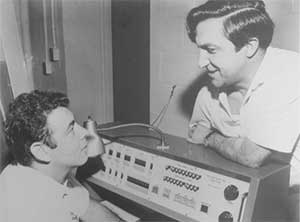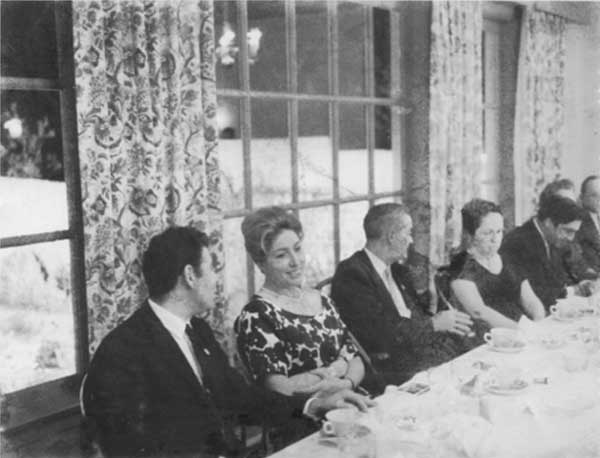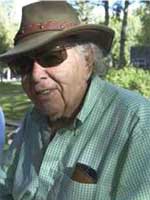In Memory of Martin M. Block
By Silvio Bergia, University of Bologna and National Institute for Nuclear Physics, Bologna (Italy); bergia@bo.infn.it and Giorgio Dragoni, University of Bologna, and National Institute for Nuclear Physics, Bologna (Italy); dragoni@bo.infn.it
Recollections of studies and discoveries by American physicists in the last century have been widespread, one example being those cited in David Kaiser’s 2011 book[1]. We believe that certain authors, however, have not received sufficient attention, one being Martin M. Block, who passed away at the age of 90 on July 22, 2016. Martin is fondly remembered in Italy because between 1961 and 1964 he collaborated there on an interesting set of research projects with Italian authors. Various physicists, particularly in Bologna and Pavia, remember his research projects, and that he and his wife and children struck up friendships with their peers. In this article, we try to provide an account of his life and studies in Italy.
Life and Early Research Activity
Martin M. Block was born on November 29, 1925 in Newark, New Jersey. He pursued his studies of physics at Columbia University in New York, and received his doctorate there in 1951. Between 1958 and 1959 he received a John Simon Guggenheim Fellowship and, in 1964, the Unesco Fellowship, as well as one given by NATO during the years 1964-65. As an assistant professor at Duke University, in Durham, North Carolina, he guided a Cosmic Ray High Energy Group that, after the introduction of the bubble chamber invented by Donald Glaser in 1952, built a liquid helium bubble chamber with the collaboration of W. M. Fairbank (1958).

Physicists Block and Puppi at work in Bologna during the Sixties Courtesy of Prof. Giovanna Puppi, Bologna (Italy)
While Block was an experimental physicist, he participated in the famous Rochester Conferences and retained an interest for theoretical physics. A subject of great interest for various physicists was a reflection about the validity of the conservation law in the phenomena of the weak interactions. That validity was generally accepted, but not experimentally confirmed. The situation was clearly described by Chen Ning Yang, on the occasion of his acceptance of the Physics Nobel Prize (11 December 1957), entitled “The Law of Parity Conservation and other Symmetry Laws of Physics.” In it, one reads the following: “The situation that the physicist found himself in at that time has been likened to a man in a darkroom groping for an outlet. He is aware of the fact that in some direction there must be a door, which would lead him out of this predicament, But in which direction? … The fact that parity conservation in the weak interaction was believed for so long, without experimental support was very startling. …”[2]. Fascinated by these issues, Block proposed that in the weak interactions parity was not conserved, which would then explain the tau/theta puzzle, a subject of great actuality in those days, but he did not dare to formally transmit his view to the participants at the conference. Richard Feynman, however, communicated Block’s idea to the participants, as mentioned in his 1985 book[3], Surely You’re Joking, Mr. Feynman: “Anyway, I was sharing a room with a guy named Martin Block, an experimenter. And one evening, he said to me: ‘Why are you guys so insistent on this parity rule? Maybe the tau and theta are the same particle. What would be the consequences if the parity rules were wrong?’ I thought a minute and said: ‘It would mean that nature’s laws are different for the right hand and the left hand, that there’s a way to define the right hand by physical phenomena. I don’t know that that’s so terrible, though there must be some bad consequences of that, but I don’t know. Why don’t you ask the experts tomorrow?’ He said: ‘No, they won’t listen to me. You ask.’ So the next day, at the meeting … I got up and said, ‘I’m asking this question for Martin Block: What would be the consequences if the parity rule was wrong?’ Murray Gell-Mann often teased me about this, saying I didn’t have the nerve to ask the question for myself. But that’s not the reason I thought it might very well be an important idea.”
According to another version, quoted by Martin Gardner in “The Ambidextrous Universe. Left, Right and the Fall of Parity”, Feynman would later speak of making “a fifty dollar bet with a friend that parity would not be violated”[4].
At any rate, the idea, initially not quite understood, if not actually rejected outright, was developed by Lee and Yang, who presented it in a famous article[5]. Later on, the question posed by the Chinese-American physicists as to whether parity was preserved in the weak interaction was shown to have a negative answer. Madame Chien Shiung Wu of Columbia led a team that found experimentally parity violation in the beta decay of Cobalt 60[6]. A number of other experiments on the subject were carried out near-simultaneously. We recall one of the first papers in 1957 by an international collaboration: “Demonstration of Parity non Conservation in Hyperon Decay”[7].The experiment was carried out thanks to the collaboration of four groups of physicists, two Italian (Bologna and Pisa) and two from the US (Brookhaven National Laboratory and the University of Michigan), consisting of some twenty physicists in all. This work contributed to the background of the award of the 1957 Physics Nobel Prize to Tsung-Dao Lee and Chen Ning Yang for their theoretical analysis of the phenomena related to weak interactions.
These two winners of the Prize did not mention Martin Block. Nor was a Nobel Prize was award to Madame Wu. The episode evidently weighed heavily on Block. During the years he spent in Bologna he often used, in his accented Italian, the expression “Maledetti teorici!” to dismiss theorists.
Block’s activity as an experimental physicist was mainly characterized by the set-up of advanced instruments for the research in elementary particles physics. In particular, he contributed to the realization of the magnet for the accelerator, then of the highest energy, the Nevis Cyclotron of the New York Columbia University.
Block remained at the Duke University until 1961, when he got a professorship as professor of physics at Northwestern University. Financial support allowed him to visit European laboratories and universities occasionally, including the Physics Institute at Bologna directed by Giampietro Puppi.
Block carried out research in Italy, frequently with Italian colleagues of the research group directed by Giampietro Puppi in Bologna, which was engaged in studies of elementary particle physics with particular attention to the determination of quantum numbers, spin, parity and isotopic spin of particles as well as of resonances.
Martin Block worked actively with Italian colleagues, aside from Puppi also R. Gessaroli, L. Grimellini, L. Lendinara, L. Monari, S. Ratti. Among other things this work achieved the observation (perhaps the first) of the decay of the Sigma Minus as well as the Lambda Zero, using for the first time a liquid helium bubble chamber[8]. Another run of the same bubble chamber photographed 100.000 interactions of the K minus[9]. A systematic study of K minus interactions in liquid helium followed in 1964[10].
Other work that deserved mention include “Helicity of the proton from a Decay”[11], “Lifetime of the Lambda 0 Hyperon”[12], “The Decay Modes of the He 4 Hypernucleus”[13], “The Lambda 0 Decay Asymmetry Parameter and the Kappa-Lambda Parity”[14]. These works belonged to a package of papers worked out by groups of authors who, besides Block and colleagues at Bologna, also included American physicists.

Block and Puppi at Durham Sept 23, 1960. (Martin Block is the first at left, then Mrs Puppi; Professor Puppi is in the fifth seat) - Courtesy of Prof. Giovanna Puppi, Bologna (Italy)
After returning to Duke, where he would remain for the rest of his career, Block widened his technical background, and built large spectrometer counter and spark chamber systems. He had studied these while a member of the Ford Foundation at CERN in 1964-65, and in 1972-73, when he was a Fellow of the Giuseppe Cocconi’s laboratory. In this work, he made use of heavy liquid chamber in order to measure neutrino interactions, the first experiment of this kind. Block was also the first to measure the relative parity of two strange particles, determining that the parity of the Lambda 0 and the Kappa 0 is odd. In 1970, his interests moved towards the technique used for measuring cross sections of high energy scattering that he studied at Brookhaven National Laboratory.
Recognitions
In 1985, in Block’s honor, Pavia University organized a symposium, “On Weak Interactions,” and that same year awarded him for his contribution to the particle physics the “Medaglia Teresiana,” which was only the third time it had been given out since the end of the Second World War. In 1985, Block obtained the medal of the Italian Physical Society, for his researches in high energy physics. That same year as well, Block initiated, in Aspen, a Winter Conference at the Aspen Center for Physics in elementary particle physics. The first conference was so well received that it has been repeated annually ever since, with topics including astrophysics, biophysics, and condensed matter physics. Ten years after its founding, the Center celebrated Block for these specialized conferences, including a public event at the Wheeler Opera House.
Giorgio Giacomelli and others organized a meeting entitled, “Thirty Years of Bubble Chamber Physics” (Bologna, Italy, 19 March 2003 at the Science Academy) attended by Block himself. Block was also honored by the dedication of a symposium in 1996 for his forty-five years of physics at the Northwestern University (Evanston-Chicago), where he was named Emeritus Professor. In 2005, to celebrate his eightieth birthday, Block and others founded the Block Prize to be awarded to promising young physicists on the occasion of the Aspen Winter Conferences. Block subsequently retired from academic life and remained with his wife Beate in a lodge in his beloved Aspen. Notwithstanding this retirement, he continued to produce several important scientific contributions.
In 2010 he gave rise to a series of papers of which one, “Hadronic cross sections: from cyclotrons to colliders to cosmic rays,” was presented at the International Symposium on the high energy cosmic rays at the Fermilab. He also wrote a brief note on the high energy scattering of neutrinos that appeared on Physical Review D. In 2011, he published two other articles, about sixty years after the publication of his first papers. The Aspen Centre for Physics announced the death of Martin Block, at the age of ninety, in Los Angeles on July 22, 2016.
Concluding Considerations

Grateful Acknowledgments: particular thanks to Professor [Mrs] Lella Grimellini, who gave us the Bologna Martin Block papers and Professor [Mrs] Giovanna Puppi for giving us photographic images of Block together with Gianni Puppi. We also thank for useful suggestions Professor Attilio Forino of the Bologna Department of Physics and Astronomy and the friend Doctor Paolo Cinti of the same Department
Bibliography:
[1] D. Kaiser, How the Hippies saved Physics, W. W. Norton & Company (2011); tr. It., “Come gli Hippies hanno salvato la Fisica”, Castelvecchi Ed., Roma, (2012)
[2] C. N. Yang, “The Law of Parity Conservation and other Symmetry Laws of Physics,” in Nobel Lectures, Physics 1942-1962”, published for The Nobel Foundation by the Elsevier Publishing Company, New York, (1964) 393-405, 398
[3] R. Feynman, R. Leighton, Surely You’re Joking, Mr. Feynman, W.W. Norton, New York, (1985); tr. it. Zanichelli, Bologna, (1988)
[4] M. Gardner, The Ambidextrous Universe. Left, Right and the Fall of Parity, Basic Books Inc., New York, (1964); tr. It. L’universo ambidestro, Zanichelli, Bologna, (1984)
[5] T.D. Lee, C.N. Yang, “Question of parity conservation in weak interactions”, Physical Review, 104, 1, (1956) 254-258
[6] C.S. Wu et al., “Experimental test of parity conservation in beta decay”, Physical Review 105, 4, (1957) 1413-1415
[7] Eisler, F. et al., “Demonstration of parity non conservation in hyperon decay”, Phys. Rev. 108 (1957) 1353; we remind that among the usual “et al.” were included various italian physicists: Bassi, Conversi, Puppi…
[8] L. Grimellini, T. Kikuchi, L. Lendinara, L. Monari, M. M. Block, ”Observation of the Decay Sigma-“, Proceedings of 1962 Int. Conf. on High-Energy Physics at CERN, Ginevra, (1962) 457
[9] M.M. Block, C. Meitzer, S. Ratti, L. Grimellini, T. Kikuchi, L. Lendinara, L. Monari, “Lifetime of the Hypernucleus H3”, Proceedings of 1962 Int. Conf. on High Energy Physics at CERN, Ginevra, (1962) 458-459
[10] L. Grimellini, L. Lendinara, L. Monari, M. M. Block, R. Gessaroli, “Interazioni di K- a riposo in He 4”, Supplemento al Nuovo Cimento, 2, 1, (1964) 735-736
[11] J. Leitner, L. Gray, E. Harth, S. Lichtman, J. Westgard della Syracuse University di New York; M. Block, B. Brucker, R. Gessaroli, A. Kovacs, T. Kikuchi, C. Meltzer of the Duke University, Durham; H. O. Cohn, W. Bugg, dell’ Oak Ridge National Laboratory, Oak Ridge; A. Pevsner, P. Schlein, M. Meer of the Johns Hopkins University, Baltimore; N. Tomasini Grimellini, L. Lendinara, L. Monari, G. Puppi of the Bologna University in Physical Review Letters, 7, n°6, 15 (1961) 264-268
[12] M. M. Block, R. Gessaroli, S. Ratti, Nothwestern University, Evanston; L. Grimellini, T. Kikuchi, L. Lendinara, L. Monari of the Bologna University; E. Harth, W. Becker della Syracuse University, New York; W. M. Bugg, H. Cohn del Oak Ridge Natiional Laboratory, Oak Ridge in Physical Review, 150, 2, (1963) 766-768
[13] M. M. Block, R. Gessaroli, s. Ratti, Northwestern University, Evanston; L. Grimellini, T. Kikuchi, L. Lendinara, L. Monari, Physics Institute, Bologna; E. Harth, Syracuse University, Syracuse, Il Nuovo Cimento, 10, 28, (1963) 299-308
[14] L. Gray, E. Harth, J. Leitner, Syracuse University; J. Auman, M. M. Block, R. Gessaroli, T. Kopelman, S. Ratti, Northwestern University; L. Grimellini, T. Kikuchi, L. Lendinara, L. Monari, Physics Institute, Bologna in Il Nuovo Cimento, 10, 28 (1963) 179-183
The articles in this issue represent the views of their authors and are not necessarily those of the Forum or APS.
